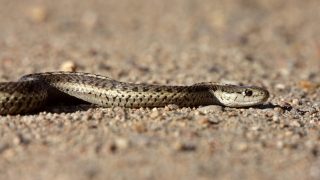Snakes in Hawaii are a big concern, and USDA said that a 20 year old man brought a live snake in his backpack to Hawaii. The snake wasn’t noticed until he checked into his vacation rental and the snake slithered out to enjoy the islands.
The young snake, one foot long, was a black racer snake, which is not venomous, and is widely seen in Florida. USDA said, “the brown-colored snake appears to be a newborn, measuring about a foot long and 1/4 inch in diameter.” When full grown, the snake could have reached up to 6 feet long, and could have caused significant damage.
Officials said the man was not aware of the snake until it emerged at a vacation rental property. Okay?
DNLR was notified and captured the snake, and it was being transported to Honolulu. Hawaii Department of Agriculture said, “it is fortunate that the owner of the rental was aware of the seriousness of the snake being transported to Hawaii and took appropriate action and reported it. Visitors to our islands may not fully understand the threat that snakes pose to our community and our unique environment.”
No land snakes in Hawaii.
There are no native snakes here, and it is illegal to possess snakes in Hawaii. Recently, Hawaii Agriculture intentionally imported four brown tree snakes for a special purpose. The snakes are used to help four specially trained dogs detect snakes that could enter the state via passengers or cargo.
Brown tree snakes were responsible for decimating Guam’s bird population when they invaded that island.
Hawaii does have one native snake, the yellow bellied sea snake. It does not come on land and it is rare to see in Hawaii. Somehow with our focus on cheap flights to Hawaii, we’ve just never seen one. They have a bright yellow bottom and a dark colored top. It is reclusive by nature.
Get Breaking Hawaii Travel News







Hawaii is home to the Brahminy Blind Snake, a diminutive black snake that has a penchant for gardens.
Believed to have arrived via potting soil from the Philippines in the 1930s, the Brahminy Blind Snake—otherwise known as the Flowerpot Snake, the Island Blind Snake, and the Hawaiian Blind Snake—looks like an earthworm, feeds on ants and termites, seeks shelter under nests, humus, logs, and leaves, and is, at approximately six inches in length, one of the smallest snakes in North America. And, much like the plants and insects of the islands—products of a place in which there are no natural predators—the Hawaiian Blind Snake is non-venomous, a feature that renders it radically different from its cousins around the world, who—like the Western Rattlesnake of California—are fiercely toxic.
Thanks for your article. I had no idea Hawaii was snake free essentially. You learn something new everyday!
Hi Shemaine.
Thank you.
Aloha.
Please consider: “Hawaii Agriculture intentionally imported four brown tree snakes for a special purpose. The snakes are used to help four specially trained dogs detect snakes that could enter the state via passengers or cargo.”- why don’t they just import trained dogs from Guam?
Good Idea :0)
I think people who bring snakes to Hawaii should be prosecuted to the fullest extent of the law. All it takes is a female ready to lay eggs to wreak havoc in Hawaii going forward. We need cognizant and vigilant inspectors on both sides of the trip. Once released, you can’t put the genie back in the bottle.
I agree 100%! Ignorance is not an excuse!